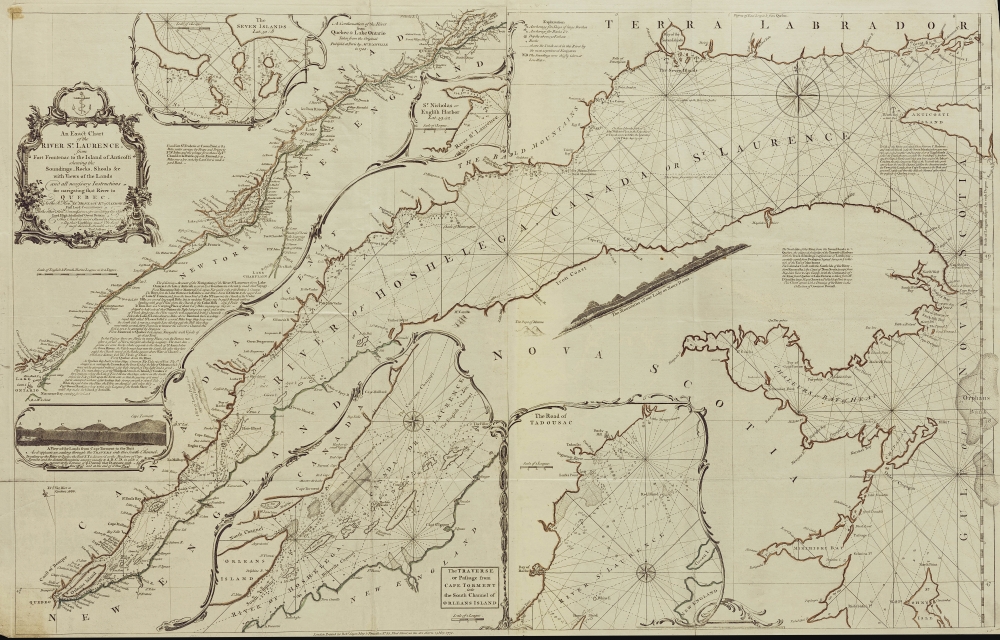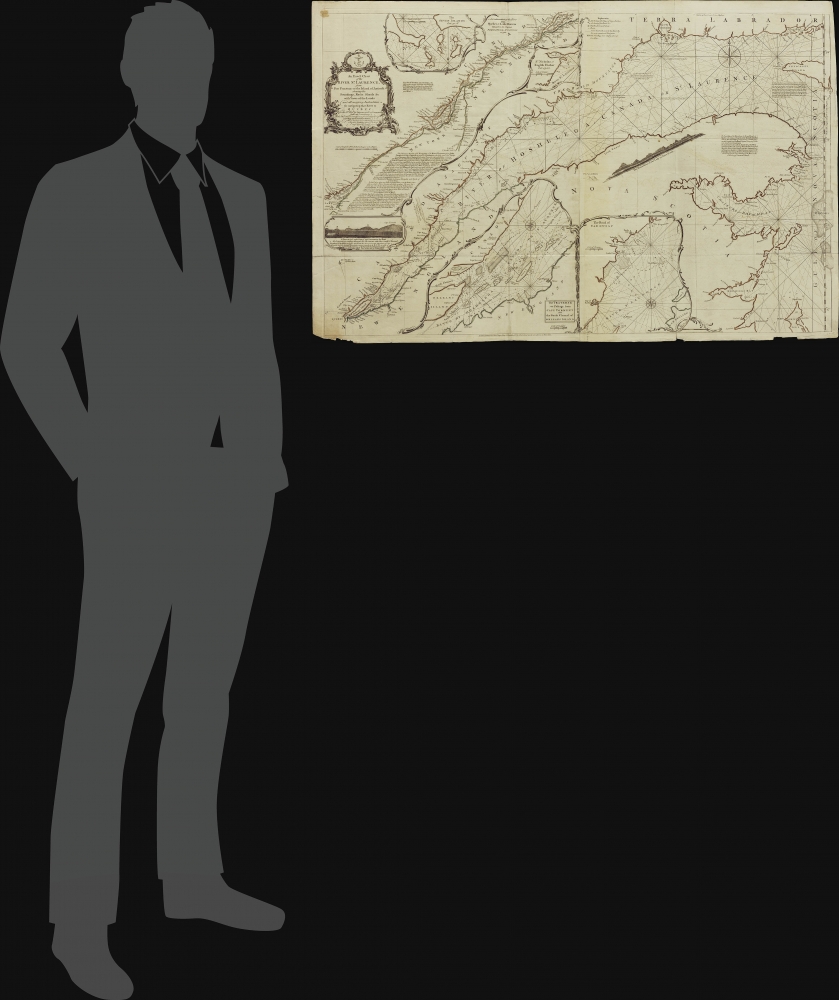This item has been sold, but you can get on the Waitlist to be notified if another example becomes available, or purchase a digital scan.
1775 Jefferys Chart of the St. Lawrence River
StLawrence-jefferys-1775
Title
1775 (dated) 25 x 38 in (63.5 x 96.52 cm) 1 : 695000
Description
A Closer Look
The main part of the map depicts the river from Anticosti Island to Quebec. Rhumb lines appear throughout, along with soundings, hazards, anchorages, shoals, profiles of the coastline, explanatory notes, and other details of importance to a navigator aboard a ship. The chart is flanked, above and below, by several insets (one based on d'Anville's map, and four others depicting important stretches of the river with greater detail):- The Seven Islands
- A Continuation of the River from Quebec to Lake Ontario taken from the Original Published at Paris by Mr. d'Anville in 1755
- A Continuation of the River from Quebec to Lake Ontario taken from the Original Published at Paris by Mr. d'Anville in 1755
- St. Nicholas or English Harbor
- A View of the Lands from Cape Torment to the Butt
- The Traverse or Passage from Cape Torment into the South Channel of Orleans Island
- The Road of Tadousac
Jefferys' Sources
The St. Lawrence was a highway for the French along which flowed an increasing volume of trade, and accurate charts were an essential. In 1702, Jean Deshayes carried out an exhaustive survey, and the resulting map became the standard until it was superseded by the British Royal Naval surveys of the later 18th century by James Cook and others. For the present work Jefferys translated the notes on Deshayes' chart into English, and updated the mapping of the area between Lake Ontario to Quebec (employing J.B.B. d'Anville's 1755 map of Canada). The result was the best British mapping of the river to that time, providing an eminently useful sailing chart through arguably the most important waterway in the Americas.Publication History and Census
The present chart appeared in 1775 in Jefferys' American Atlas, the publication of which was prompted by the recent conflict with the French (Seven Years' War) and the growing tensions between the British government and its colonies. The importance of the St. Lawrence River was well-understood as a strategic corridor and the main conduit for trade to and from the prosperous Canadian settlements.CartographerS
Thomas Jefferys (1695 - November 20, 1771) was one of the most prominent and prolific map publishers and engravers of his day. Jefferys was born in Birmingham and was apprenticed to the engraver Emmanuel Bowen in 1735. Later, in the 1740s he engraved several maps for the popular periodical Gentleman's Magazine. Around 1740 Jefferys was finally able to go into business for himself and in 1746 received an appointment as 'Geographer to Fredrick, Prince of Wales,' which shortly after translated to the position of 'Royal Cartographer to King George III.' Jefferys initially specialized in compiling and re-engraving the works of earlier cartographers into more coherent cartographic wholes. Later, while not salaried position, Jefferys' appointment as 'Royal Cartographer' guaranteed preferential access to the most up to date cartographic material available, allowing him to produce new and updated charts of exceptional accuracy. He his best known for his maps of the Americas, particularly the posthumously published 1775 American Atlas, which included some of the finest and most important late colonial era maps of America ever made. Despite his prolific publishing history, royal appointments, and international publishing fame, Jefferys lived most of his life in dire economic straits. He was bailed out of bankruptcy by Robert Sayer during the production of the American Atlas. In the end, Jefferys died suddenly with very little to his name. Nonetheless, his cartographic legacy survived, and even after his death in 1771, many of his important maps continued to be published and republished by Sayer and Bennet, Conrad Lotter, Georges Louis Le Rouge, Laurie and Whittle, and others. Many attribute some of Jefferys best maps to the colorful and criminally inclined Irish cartographic genius Braddock Mead (John Green, c. 1688 - 1757), who is considered the 'secret behind Jefferys.' Jefferys was succeeded by his son, also Thomas, who had little success as a cartographer and eventually partnered with, then sold his stock and plates to William Faden - Jefferys' true heir. More by this mapmaker...
Robert Sayer (1725 - January 29, 1794) was an important English map publisher and engraver active from the mid to late 18th century. Sayer was born in Sunderland, England, in 1725. He may have clerked as a young man with the Bank of England, but this is unclear. His brother, James Sayer, married Mary Overton, daughter-in-law of John Overton and widow of Philip Overton. Sayer initially worked under Mary Overton, but by December of 1748 was managing the Overton enterprise and gradually took it over, transitioning the plates to his own name. When Thomas Jefferys went bankrupt in 1766, Sayer offered financial assistance to help him stay in business and, in this way, acquired rights to many of the important Jefferys map plates as well as his unpublished research. From about 1774, he began publishing with his apprentice, John Bennett (fl. 1770 - 1784), as Sayer and Bennett, but the partnership was not formalized until 1777. Bennett retired in 1784 following a mental collapse and the imprint reverted to Robert Sayer. From 1790, Sayer added Robert Laurie and James Whittle to his enterprise, renaming the firm Robert Sayer and Company. Ultimately, Laurie and Whittle partnered to take over his firm. Sayer retired to Bath, where, after a long illness, he died. During most of his career, Sayer was based at 53 Fleet Street, London. His work is particularly significant for its publication of many British maps relating to the American Revolutionary War. Unlike many map makers of his generation, Sayer was a good businessman and left a personal fortune and great estate to his son, James Sayer, who never worked in the publishing business. Learn More...




